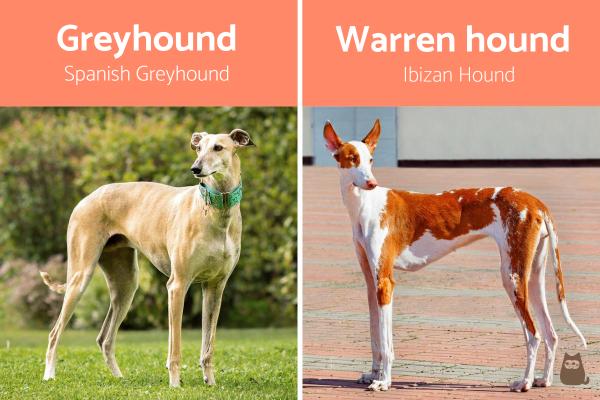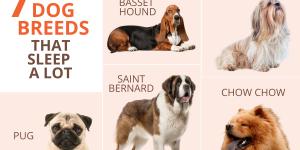Greyhound vs Warren Hound



See files for Dogs
At first glance, the Greyhound and the Warren Hound, also known as the Podenco, may look very similar. After all, they are both slender, athletic dogs and widely known for their hunting abilities. Nevertheless, they differ both physically and psychologically. The origins of both dogs are quite old, and they have been used for centuries to hunt rabbits and other small animals. Although both dogs are quite fast, the greyhound is actually the fastest dog in the world and therefore has been used in races for decades.
The following AnimalWised article explains the main differences between greyhounds and warren hounds in terms of health, care, behavior, and appearance.
Origin of the Greyhound and the Warren Hound
Greyhounds and Warren hounds are both ancient breeds, as evidence of their existence dates back to the Pharaonic era of Ancient Egypt, where artistic and architectural representations of dogs similar to them were engraved.
Origin of the Greyhound
The term greyhound, also known as Galgo in Spanish, comes from the Vulgar Latin gallicus canis, meaning "dog of Gaul". Even in Ancient Greece and Rome, greyhounds were used for hunting and catching rabbits. During the Middle Ages, they spread throughout the Middle East and Europe and eventually made their way to Britain, where they became a status symbol. Greyhounds are great running dogs that can reach up to 70 km/h. In fact, in the animal kingdom, they are surpassed in speed only by the cheetah. At the beginning of the 20th century, greyhounds became very popular in the canodromes, which were fashionable in England at that time. Today, greyhounds have left the world of racing behind and have become a popular pet due to their good-natured nature.
Origin of the Warren Hound
Warren hounds, also called Podencos, are believed to be descended from Egyptian breeds such as the Tesem, a now extinct dog with very similar characteristics to modern Podencos, which accompanied the Pharaohs and performed protective and hunting duties. However, it was the Phoenicians who spread their trail throughout the Mediterranean, where the warren hounds settled mainly in Italy, Malta and the Iberian Peninsula. Nowadays, Spain and Portugal are the areas where most of the different types of Podencos are native, including the Valencian, Ibizan, Andalusian and Canarian types.
If you are interested in other old Spanish breeds such as the Greyhound and the Warren Hound, you should not miss the following article, where we list the most popular Spanish breeds.
Physical characteristics of the Greyhound and the Warren Hound
Both Greyhounds and Warren hounds have a slender, graceful, and athletic build, with fine muzzles, strong limbs, and long tails that are perfect for racing. However, they also differ in several physical aspects.
Physical characteristics of Greyhounds
- Greyhounds have a small and mostly black nose.
- Their ears are also quite small, set high, triangular and with a rounded tip.
- Their body is characterized by a deep chest and a natural slenderness that makes it easy to feel the ribs and the shape of the Greyhound's spine, which stands out against a slightly arched back.
- As for the coat, there are short-haired Greyhounds, like the Spanish, Italian or English, and long-haired Greyhounds, like the Afghan or Russian, and they can all have different coat colors. The colors range from white to black, cream, brown, gray, or even brindle and tricolor.
- The greyhound is slightly larger than the Warren hound on average, although there are numerous varieties of both breeds, each with specific physical characteristics and sizes.
Physical characteristics of Warren Hounds
- The nose of the Warren hound can be black, pink, or brown, and it is also common for its lips and eyes to have a lighter color than those of the Greyhounds.
- One of its main distinguishing features is its large triangular ears, which are perfectly erect and give the Warren hound an always alert appearance.
- Their body resembles that of the greyhound, although the Warren hound is usually not so slender and has a straighter back.
- In terms of the coat, although there are no very long-haired varieties, there are short-haired varieties like the Ibizan or Andalusian, and semi-long-haired and rough varieties like the Portuguese. the main colors of their coat are: Brown, yellow, chocolate, and white.
If you want to learn more about the greyhound breed, do not miss the following article, where we explain the main characteristics and differences between the Spanish greyhound and the English greyhound.

Character of the Greyhound and the Warren Hound
As hunting dogs, Greyhounds, and Warren hounds have quite similar temperaments, although Warren Hounds are generally more active and playful.
Character of the Greyhound
Greyhounds are very active, sensitive and friendly dogs. Both breeds, but especially greyhounds, tend to be somewhat shy and reserved, which makes it easy for them to develop fears and phobias if they are not properly socialized as puppies. However, if this aspect is taken care of and their physical, social and emotional needs are met, these dogs enjoy the company of people and other dogs, are playful and rarely exhibit aggressive behavior.
Character of the Warren hound
Warren dogs are very affectionate and sensitive. They are very loyal, usually have a fondness for children, and make excellent pets in the right home. They can be very loud and require lots of company. It is not a breed that can be left alone for hours at a time.
Both breeds require long daily walks to satisfy their need for physical exercise and sensory stimulation, preferably in a place where they can run freely or explore the environment. However, at home they tend to be calm and sleepy, so they adapt perfectly to life in an apartment.
If you want to learn more about the socialization process dogs must go through to avoid behavior problems, do not miss this other article, where we explain how to socialize both puppies and adult dogs.
Care of the Greyhound and the Warren Hound
Both breeds are relatively low maintenance and do not require special care. However, some considerations must be made in order to provide the dogs with a healthy, long and happy life.
Care of the Greyhound
- Protect them from the cold: they are dogs that can suffer from low temperatures. This is because their fur is very short and not very dense. In such cases, clothing for dogs is necessary.
- Exercise: they are dogs that do not need long walks to get tired. The best thing for them is a few short but quick runs.
- Grooming: although the greyhound does not shed large amounts of hair, we can brush them regularly to facilitate the change of coat. Otherwise, they are quite clean dogs, as they tend to groom themselves. It is enough to wash them once a month.
- Diet: Diet plays a very important role in the overall health of the greyhound. Their strength, endurance, and speed depend on it. Therefore, the diet must have a balanced content of proteins, fiber, vitamins, and minerals. We also need to provide our greyhound with a sufficient amount to meet the needs of each nutrient, so as not to limit the development and functionality they need.
Care of the Warren hound
- Training: They will quickly learn the basic commands and if you want to continue working with them, they will do it gladly because they love to obey.
- Exercise: Since warren hounds have been working for centuries in hunting, that is why they will need physical activity as well as stimulation and intelligence exercises. The warren hound will adapt to almost any type of housing, they do not need much space as long as you take it for a walk three to four times a day.
- Grooming: You will only have to brush them once a week to remove dead hair and keep the coat shiny. For bathing, it will be enough once a month or every two months in winter.
- Diet: Your Warren Hound's diet should contain the proper balance of all the major nutrient groups, especially because it is a very active breed. This dog burns calories quickly due to its high physical activity, so it is rarely overweight.
Health of the Greyhound and the Warren Hound
Although both breeds are known for their hardiness and good health, they can suffer from certain genetic diseases just like any other breed. Knowing about these potential diseases is important because it allows us to be vigilant and make an early diagnosis.
Health of the Greyhound:
The Greyhound is a robust breed with few known health problems. Some neurological disorders have been reported, but they are not very common. We can talk about common diseases in Greyhounds due to genetic predisposition, but these include:
- Bone cancer: Bone cancer is a common cancer in dogs, especially in large and giant breeds. These tumors are very aggressive and are characterized by painful destruction of the bones where the tumor grows. Learn more about bone cancer in dogs in this other article.
- Gastric torsion: Stomach torsion is the condition in which the stomach rotates around itself, causing tremendous pressure and even cutting off blood circulation in the stomach area. Learn more about gastric torsion in dogs in this other article.
- Hip dysplasia: when there is a hip dysplasia, the head of the femur does not fit well into the hip socket, causing pain and bone wear due to an abnormal development.
Health of the Warren hound:
Warren dogs are also a very healthy breed. As for possible diseases, like any breed, they are prone to certain hereditary diseases such as:
- Elbow and Hip Dysplasia: Just like Greyhounds, Warren Hounds are very susceptible to this condition, both at the elbows and hips.
- Epilepsy: Epilepsy is a chronic disorder that results in repeated seizures and is the most common chronic (long-term) neurological disorder in dogs.
- Testicle tumors: As the male dog gets older, he may develop a tumor in the testicles. This tumor is one of the most commonly observed in unneutered male dogs, after skin tumors.
If you want to learn more about other fast dog breeds, do not miss this other article, where we present the fastest dog breeds in the world.
If you want to read similar articles to Greyhound vs Warren Hound, we recommend you visit our Comparisons category.
- Burnham, AC, Ordeix, L., Alcover, MM, Martínez-Orellana, P., Montserrat-Sangrà, S., Willen, L., Spitzova, T., Volf, P., & Solano-Gallego, L. ( 2020). Exploring the relationship between susceptibility to canine leishmaniosis and anti-Phlebotomus perniciosus saliva antibodies in Ibizan hounds and dogs of other breeds in Mallorca, Spain. Parasites & Vectors , 13 (1), 129. https://doi.org/10.1186/s13071-020-3992-8
- Online research resources developed at NHGRI. (s/f). Online Research Resources Developed at NHGRI. Retrieved December 23, 2021, from https://research.nhgri.nih.gov/dog_genome/
- International Cinological Federation (1998). Spanish Greyhound . Available at: http://www.fci.be/Nomenclature/Standards/285g10-es.pdf
- International Cinological Federation. (2000). Ibizan Hound. Available at: http://www.fci.be/Nomenclature/Standards/089g05-es.pdf






